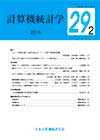Volume 29, Issue 2
Displaying 1-18 of 18 articles from this issue
- |<
- <
- 1
- >
- >|
-
2017Volume 29Issue 2 Pages Cover1-
Published: 2017
Released on J-STAGE: March 28, 2018
Download PDF (101K) -
2017Volume 29Issue 2 Pages App1-
Published: 2017
Released on J-STAGE: March 28, 2018
Download PDF (42K) -
2017Volume 29Issue 2 Pages i-
Published: 2017
Released on J-STAGE: March 28, 2018
Download PDF (75K) -
2017Volume 29Issue 2 Pages ii-
Published: 2017
Released on J-STAGE: March 28, 2018
Download PDF (31K)
Papres
-
2016Volume 29Issue 2 Pages 117-131
Published: 2016
Released on J-STAGE: May 01, 2017
Download PDF (1957K) -
2016Volume 29Issue 2 Pages 133-146
Published: 2016
Released on J-STAGE: May 01, 2017
Download PDF (2607K)
Reviews
-
2016Volume 29Issue 2 Pages 147-148
Published: 2016
Released on J-STAGE: May 01, 2017
Download PDF (1716K) -
2016Volume 29Issue 2 Pages 149-157
Published: 2016
Released on J-STAGE: May 01, 2017
Download PDF (5294K) -
2016Volume 29Issue 2 Pages 159-167
Published: 2016
Released on J-STAGE: May 01, 2017
Download PDF (3745K) -
2016Volume 29Issue 2 Pages 169-179
Published: 2016
Released on J-STAGE: May 01, 2017
Download PDF (2818K) -
2016Volume 29Issue 2 Pages 181-188
Published: 2016
Released on J-STAGE: May 01, 2017
Download PDF (6997K) -
2016Volume 29Issue 2 Pages 189-195
Published: 2016
Released on J-STAGE: May 01, 2017
Download PDF (2591K)
Report of Activities
-
2016Volume 29Issue 2 Pages 197-209
Published: 2016
Released on J-STAGE: May 01, 2017
Download PDF (2028K)
Editorial Board
-
2017Volume 29Issue 2 Pages 211-
Published: 2017
Released on J-STAGE: March 28, 2018
Download PDF (146K) -
2017Volume 29Issue 2 Pages 212-
Published: 2017
Released on J-STAGE: March 28, 2018
Download PDF (143K) -
2017Volume 29Issue 2 Pages 213-
Published: 2017
Released on J-STAGE: March 28, 2018
Download PDF (131K)
-
2017Volume 29Issue 2 Pages App2-
Published: 2017
Released on J-STAGE: March 28, 2018
Download PDF (35K) -
2017Volume 29Issue 2 Pages Cover2-
Published: 2017
Released on J-STAGE: March 28, 2018
Download PDF (28K)
- |<
- <
- 1
- >
- >|
